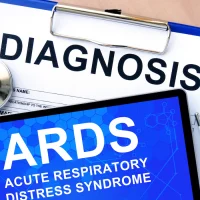At least one fifth of all patients admitted to the ICU are obese, and these patients are at risk of developing lung de-recruitment and then atelectasis. Moreover, the incidence of acute respiratory distress syndrome (ARDS) is increased in obese patients.
A major challenge of the critical care management of obese patients is successful respiratory system management. However, while obesity contributes to many diseases and is often associated with higher all-cause mortality in the general (non-selected) population, obese patients with ARDS have a similar or lower mortality risk when compared with non-obese patients with ARDS. Obese patients therefore represent a specific population of ICU patients, and could differ from non-obese patients.
Obesity and risk of ARDS
The respiratory physiology of the obese patient might explain the increased incidence of ARDS criteria in obese patients. Anatomic and physiological alterations are observed in obese patients, affecting the face, neck, pharynx, chest wall and lungs. Excess abdominal fat may increase abdominal pressure.
Atelectasis formation, increased baseline oxygen consumption and iatrogenic ventilator management could explain the higher incidence of ARDS in obese patients. The increased prevalence of gastro-oesophageal reflux disease and difficult intubation can also increase aspiration incidence during intubation, and the underlying insult of ARDS.
Although the prognosis of obese ARDS patients remains debated, it seems that obese patients with ARDS have a similar or better prognosis than non-obese patients. Despite a similar pulmonary injury, obese patients might be more prone to hypoxaemia because of a greater incidence of atelectasis, which could result in a lower PaO2/FiO2 ratio compared with normal weight patients, and therefore a misdiagnosis of ARDS.
Another key element when considering the relationship between obesity and ARDS is that clinicians might consider obese patients to be at high risk of worse outcome; this belief could result in earlier admission to the ICU. Increased monitoring, associated with an increased use of prophylactic measures, could then explain the better prognosis observed in obese patients.
Ventilator support
Lung volumes are not increased in obese patients compared to non-obese patients, and settings of protective ventilation should be applied, based on the ideal body weight and not on the real body weight. Transthoracic pressure is higher in obese patients than in non-obese patients, so driving pressure may be not appropriate to assess the severity of ARDS and to guide ventilatory management in obese patients.
Monitoring of oesophageal pressure seems particularly interesting in morbidly obese patients, in order to assess the real transpulmonary pressure and set optimal PEEP (positive end-expiratory pressure) levels. To counteract the onset of atelectasis in the dependent region of the lungs, prone positioning may be advised in obese patients with ARDS, by a trained team. To avoid the side-effects of prone positioning – increased abdominal pressure and associated complications, such as renal failure and hypoxic hepatitis – the reverse Trendelenburg position and optimal abdominal fat positioning can be used.
The use of venovenous extracorporeal membrane oxygenation (VV-ECMO) has re-emerged as an option for ARDS refractory to conventional support. In addition to cannulation difficulty, obtaining sufficient circuit flow can be challenging in morbid obese patients. There remains significant hesitancy in many centres to offer ECMO support to the obese population. A recent study reported that class III obesity was not associated with poorer outcomes in obese ECMO patients. Based on these data, also reported by others, ECMO support in ARDS patients should not be withheld from the obese patient population.
Future research
Because obesity status is often an exclusion criterion in the major randomised controlled studies in ARDS, specific outcome studies are needed in obese patients with ARDS. Future randomised controlled trials are necessary to evaluate the effect of different strategies of ARDS management on outcomes in this population. Similar evaluations should be conducted in obese patients without ARDS at admission to the ICU with the aim of preventing development of ARDS.
At present, individualised treatment remains the best option for optimal outcomes, taking into account the pathophysiology of the obese patient.
Source: Critical Care
Image credit: Pixabay










